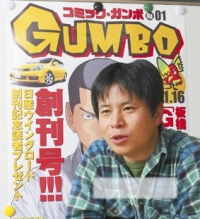An interesting piece from FujiSankei Business-i (in translation):
Animation Produced in Small Teams is a Breath of Fresh Air for the Industry: FROGMAN Co., Others Showcase A Powerful Individuality
March 13, 2007
Animation produced in small teams have been hitting the market one after the other recently, which is a new development as works are usually produced in production teams of dozens or even hundreds of people. The new works, which maintain a high level of quality while showcasing the creators’ intense vision in every nook and cranny, a feat that can only be achieved in a small team, are blowing a new wind throughout Japan’s animation industry. (by Ryuichi Taniguchi)
Improved Performance of PCs Plays a Role
Makoto Shinkai, director of “Five Centimeters Per Second” (秒速5センチメートル) gave thanks before the 200 people who had gathered to watch his animated film shown at Cinema Rise in Tokyo’s Shibuya Ward on March 3: “I am happy to show a film that I made the way I wanted it in a large space.” This was his first film since his long-form “Beyond the Clouds, at the Promised Location” (雲のむこう、約束の場所) was shown at the same theater in November 2006. He seemed to have felt a positive response from the excited crowd of waiting fans that filled the seats.
In the past, animation production was assumed to require a large staff, but Shinkai released his first 25-minute short “Voices of the Stars” (ほしのこえ) created almost entirely by himself on a PC. The imagery, which measures up to animation made by pros, and the story, about susceptible young men and women, made the piece a hit with the younger generation and gained its creator recognition as a member of the new generation of animation directors.
However, Shinkai did not choose the path of producing his work in a major studio with a large staff at his beck and call. He continued using PCs and producing his films with a small staff to complete his “Beyond” and the more recent “Five”.
Shinkai explains, “For a year and half, I had the animation staff come to my home, and created it at a steady pace using my desktop. He didn’t create the whole thing by himself as in “Voice of the Stars,” but he made drastic staff cuts compared to the number of people involved in “Beyond.” As a result, Shinkai was able to realize a film in which his vision crept into every nook and cranny, from depictions of the lyrical countryside, to the village landscapes, to the endless sky and ocean.
Productions that can make full use of the creator’s individuality because of such a small staff are made possible by high-performance PCs that can be used to draw, color, and even edit finely detailed images. It’s easy to see how individual creators like Shinkai can make it into the animation industry if they have talent and backup in terms of funding.
Product Placement Comes to Anime
The films produced by FROGMAN Co, led by a man who goes by the same name, were also born of superior talent, a PC, and the Internet. The company creates animation using Flash, an animation software that can play simple video on a PC, and began offering programs on the Internet starting in 2004. These short films gained an following, and in April 2006 FROGMAN’s “Falcon’s Claw, Secret Society” (秘密結社鷹の爪) debuted on TV Asahi.
On March 17, “Falcon’s Claw, Secret Society The Movie: The Fuhrer Dies Twice” (総統は二度死ぬ) opens in theaters. FROGMAN spoke at a sneak preview held in Roppongi on March 4: “I’m so happy because cinema is the apex of film.” Just as in the TV version, FROGMAN does almost all the voices himself and drew most of the animation. He was overjoyed to see his brainchild up on the big screen.
The big-screen version of course cost more, but the costs were covered by including product placement within the film. Since it’s a comedy, the film blatantly displays company logos and products to make the crowd laugh. They even included a “budget gauge” on the side of the screen that dips during the more elaborate CGI scenes as a gag for the audience.
Another Internet-based talent is Rareko. She published her work on the Internet and eventually worked into picture books and DVDs after they became popular. As more and more companies seek out dormant talent, it looks as though we’ll keep seeing unique, individual animation.
The Companies Backing up Individual Talent
Individuals’ talents can only blossom fully with the support of a corporation. Shinkai has received support from Comics Wave (headquartered in Shibuya) since he began work on “Voices”. CW is a company that manages publishing rights for content and scouting/development of creators. They contract with manga artists and illustrators and serve as a conduit for bargaining with companies that want to use the creators’ characters.
DLE (HQ: Chiyoda Ward), a company founded in 2001 as a company that provides consulting for the video content industry, serves as FROGMAN’s producer. In addition to producing television programs, the company also aids in Flash animation and helped bring FROGMAN into the limelight.
Fanworks (Shibuya) produces independent animation and supports Rareko, of “The Fragile Tank” (やわらか戦車) fame. When the Internet-based animation took off, they served as a conduit for commercialization demands and helped boost its popularity by forming the “Fragile Tank Coalition Force.”
—
To close out, here are some YouTube clips of some of the shows mentioned in this article:
Falcon’s Claw Secret Society:
Fragile Tank:
Five Centimeters Per Second:



